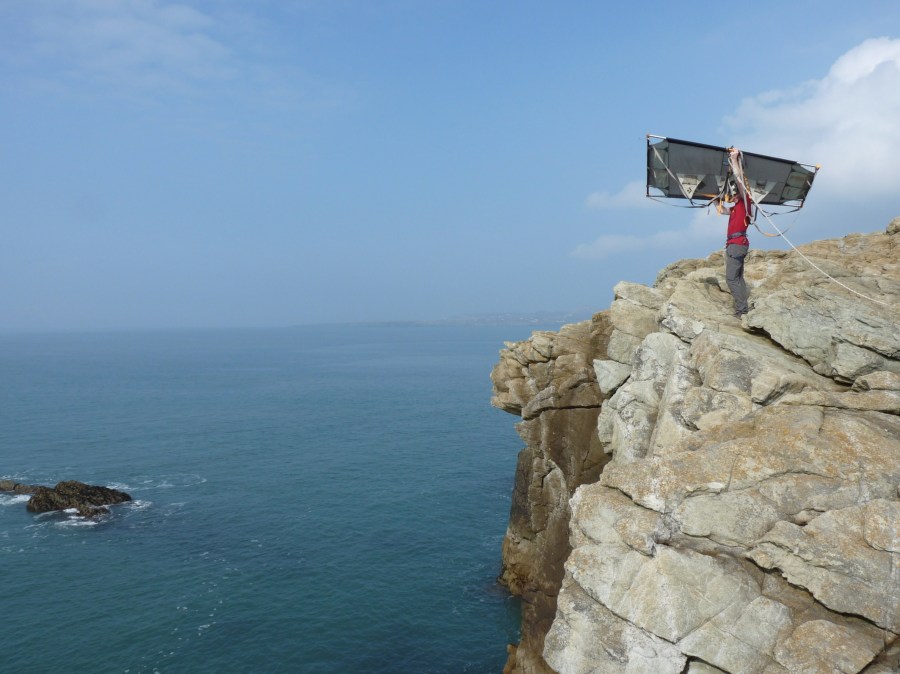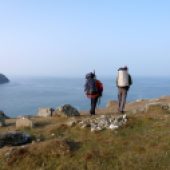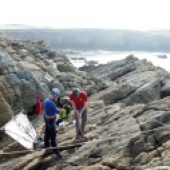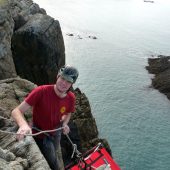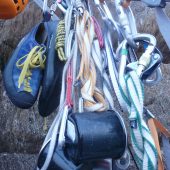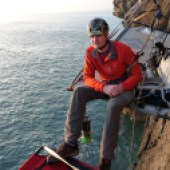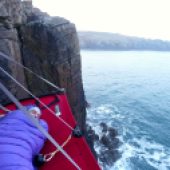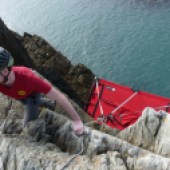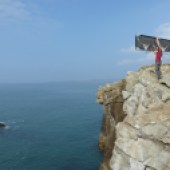Coast contributor James Stewart hangs out – and spends the night – on the side of an Anglesey cliff
This January the media was gripped by the will-they, won’t-they story of two climbers attempting the world’s toughest ascent without ropes. Kevin Jorgeson and Tommy Caldwell completed the Dawn Wall of Yosemite’s El Capitan after 19 days on 15 January. What fascinated many non-climbers was not the feat so much as a photo of the pair dangling above the void on nothing more than a fabric shelf – a portaledge.
A ripstop nylon base tensioned over an anodized aluminium frame then suspended by webbing from a cliff face, the portaledge was developed from campbeds by climbers in the mid-1980s to enable multi-day ascents of sheer walls. Perfected a decade later and often canopied, it was safer than a hammock and more comfortable over long ascents.
Tales of portaledging adventures gradually leaked from the climbing blogosphere. Non-climbers were intrigued. Now small North Wales climbing operator Gaia Adventures has launched the first ‘cliff-camping’ experience in the UK, pitching portaledges from cliffs on Anglesey or in a Snowdonia valley.
Aspiring cliff-campers don’t require climbing skills, it claims, just a love of outdoor adventures. Really? There’s only one way to find out.
10AM GEAR UP
My guide, Sam Farnsworth, is poring over equipment when I arrive at our rendezvous in Rhoscolyn, Anglesey. We’ll wear harnesses at all times, including overnight on the portaledge, and use ropes, belay devices and carabiners (spring-loaded metal clips that are hooked on to secure points) to keep us safe. Rucksacks on, we head through kissing gates beneath a flawless sky, crossing fields towards a heart-swelling panorama of sea. Cliff camping is a Marmite thing, Sam tells me: some love it, others are terrified. I’m a lapsed climber, so my head tells me I’ll be among the former. My heart is undecided. Still, the clifftop ledge that will be our base is beautiful. Pale sky and green sea merge on the horizon. Sam wasn’t wrong when he said cliff camping was pure escapism. But there’s work to do.
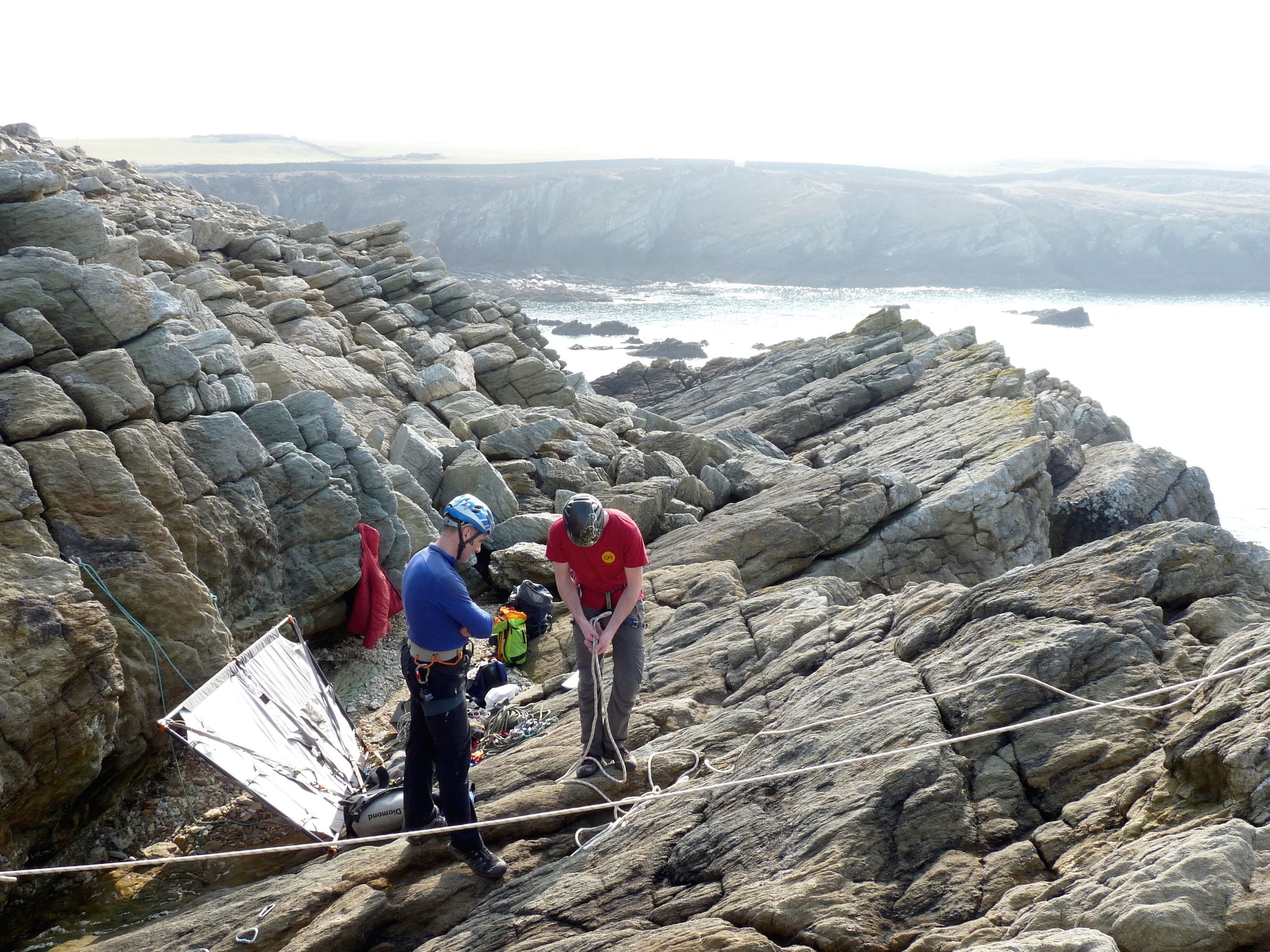
11.30AM SAFETY FIRST
First we anchor the portaledge to the summit. ‘There’s no dark art in climbing gear. It works because of physics,’ Sam says, slotting three hexes – walnut-sized nuggets of metal with steel loops of wire – into cracks. To these he ties two non-stretch ‘static’ ropes which will be clipped on to the portaledge. It looks flimsy, but each hex can take 1.2 tonnes and each rope lift a Transit van. Should that fail (almost unthinkable) a stretchy ‘dynamic’ rope will be attached to the harness I’ll wear on the ledge at all times. ‘Bombproof,’ says Sam.
12PM SPINNING AROUND
I wish I felt the same way about our portaledge. It’s perfectly safe, of course. But it falls from its bag looking like a tent that has been through a hurricane. Assembled, it transforms into what appears to be a cheap sunlounger. I peer over the cliff for the first time as we lower the portaledges, which plummet 80ft to a churning sea. The view telescopes. My head spins.
1PM UP THE WALL
But there’s no time for vertigo – we are off climbing, honing abseiling and carabiner techniques for later. So, hard hat and harness on, stepping into leg-loops, buckling up the waist, climbing boots laced, a figure-eight knot tied into my harness and I move to drop off the cliff. Sam has a belay device that uses the friction of rope through a metal plate to control my descent. A doddle, I think, until four million years of evolution screams at me not to step off the edge. Sam gently coaxes me down, then we pick off routes back up. Sam leads, placing safety gear. I follow, attached on his rope, heeding advice about toe- or handholds. A group of kayakers arrives. ‘What’s them platforms, lads?’ one asks, pointing a paddle at the dangling portaledges. We explain. He looks between them and us in silence, then shakes his head. I know the feeling.
4.30PM LIFE ON THE LEDGE
Back on the clifftop, we pack for the night: sleeping bag, bivvy bag, head-torch, thermals, woolly hat, thick socks. Again, Sam explains the physics that make the ledge ‘bomber’, then over I go, abseiling 15ft down. That tent-like fabric sags, creaking under my weight. Suddenly, the void seems terrifyingly close. Worse, the ledge jolts against the cliff with every movement. Clumsy with nerves, I struggle to clip into its central carabiner. Every action seems to require three hands. I shift to one side. The ledge pitches seaward, my stomach lurches. Sam bounces down, beaming. ‘God, I love this,’ he says. ‘Climbing takes you places you’d never have gone otherwise.’ No kidding.
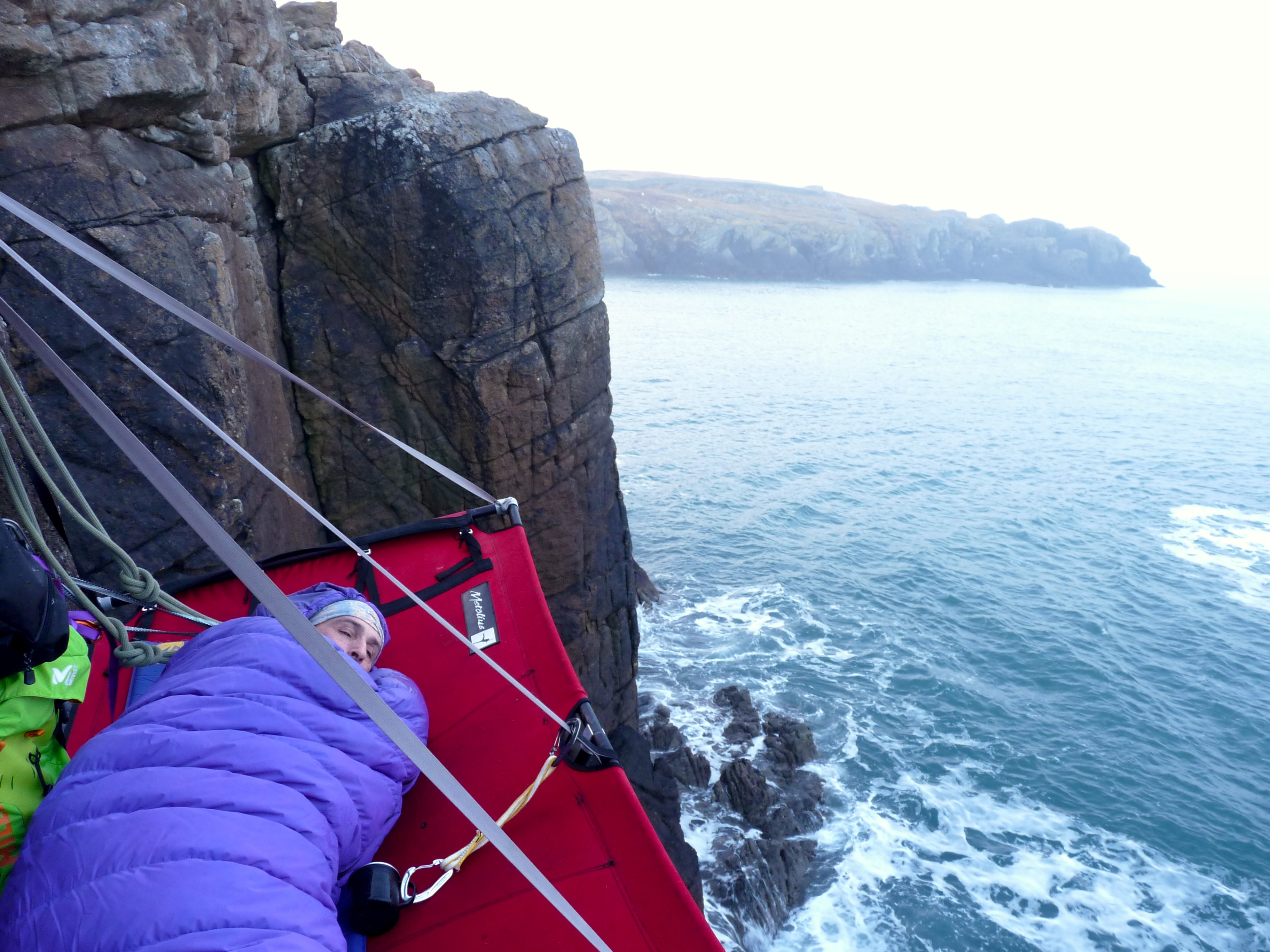
6PM DUSK
This is escapism and then some. After two hours, I can almost kid myself that I’m on an oversized hammock not dangling over the abyss. And what a view! Ahead is an edge-of-the-world panorama of empty silver sea. Waves foam around an islet. Gulls wheel. It’s beautiful, almost meditative. Enforced time out, Sam agrees.
7.15PM GRUB’S UP
Sam fires up a camping stove hung from the frame, then, beneath a bunting of helmets, carabiners and mugs clipped to the webbing, we eat ravioli as the sunset melts clouds and gilds the gulls. The sea changes from jade-green to gold, pewter then burnished steel. The lighthouse at Holyhead winks out of the haze. Stars appear.
8.30PM LIGHTS OUT
The temperature plummets as the light fades until our breath plumes in the beams of our torches. The world finally shrinks to our tiny pool of light suspended on this dark cliff. The sea whispers below. Orion blazes above. It’s almost inconceivable that everyday life continues elsewhere.
10PM SO TO BED
I’d fretted about rolling off in my sleep. Yet I’m cupped by sagging nylon when I slip into my sleeping bag (covered with a bivvy bag in case of dew). Anyway, I think as I zip up, I’m secure with the harness. Do I sleep? Fitfully. I feel I’m awake all night, yet the Plough has inched across the sky each time I look.
6.30AM LEDGE SERVICE
I’m roused as Sam clambers away up the cliff. Soon there’s the smell of frying bacon and a bag descends on a rope with a butty inside – ledge service in the UK’s barmiest hotel. Sam follows and together we breakfast in the empty space between sea and sky. Sea fog boils over the silvery water. Cormorants flit on stiff wings. ‘Aren’t we lucky?’ Sam says to me. Yes, we really are.
For more adventure inspiration, click here or pick up a copy of the magazine.
NEED TO KNOW
Gaia Adventures is the only cliff-camping provider in the UK. In poor weather, the cliff campsite switches from coastal to a sheltered inland valley in Snowdonia.
WHAT TO BRING
All climbing equipment – harnesses, gear, boots and helmets – is provided, though you’re welcome to bring your own. Gaia can also source sleeping bags and bivvy bags if required. Bring a head-torch (check the batteries) and warm clothing, plus waterproofs in a 40-50-litre daypack. Go minimal on toiletries – there are no facilities – but do consider bringing sunscreen. Yes, even in Wales.
WHAT IT COSTS
Overnight cliff camping costs £450 for one, £250 per person for two, or £190 per person for three, including dinner and breakfast. Afternoon trips cost from £90 per person for four to £250 for one.
WHERE TO STAY
Beaumaris, which is a half-hour drive from Rhoscolyn, provides the loveliest stay on Anglesey; and Gaia can collect guests. James stayed in The Townhouse, a smart modern annex of the award-winning Ye Olde Bulls Head Inn in the town centre, which also has a great brasserie and a gourmet restaurant.
ASK THE PRO
Gaia Adventures’ Sam Farnsworth slept on his first portaledge in Yosemite aged 17 and spent two weeks aloft in Venezuela in 2012. Here he explains the wonder of UK cliff camping:
‘I came back from climbing abroad and realised we also live in an amazingly beautiful country here, one where we can have similar adventures. For me, cliff camping allows a meaningful connection to that scenery and it’s not a macho day out. In fact, I find nervous people often get the most out of the experience – once they realise nothing is going to happen they relax and have a great sense of achievement. I find being here calming. People’s lives are so hectic that it’s great to just chill out and remember what a beautiful place we live in. I love those moments when you wake up, remember that you’re outdoors and feel that connection to the scenery. There’s no better start to the day.’
Coast contributor James Stewart hangs out – and spends the night – on the side of an Anglesey cliff
This January the media was gripped by the will-they, won’t-they story of two climbers attempting the world’s toughest ascent without ropes. Kevin Jorgeson and Tommy Caldwell completed the Dawn Wall of Yosemite’s El Capitan after 19 days on 15 January. What fascinated many non-climbers was not the feat so much as a photo of the pair dangling above the void on nothing more than a fabric shelf – a portaledge.
A ripstop nylon base tensioned over an anodized aluminium frame then suspended by webbing from a cliff face, the portaledge was developed from campbeds by climbers in the mid-1980s to enable multi-day ascents of sheer walls. Perfected a decade later and often canopied, it was safer than a hammock and more comfortable over long ascents.
Tales of portaledging adventures gradually leaked from the climbing blogosphere. Non-climbers were intrigued. Now small North Wales climbing operator Gaia Adventures has launched the first ‘cliff-camping’ experience in the UK, pitching portaledges from cliffs on Anglesey or in a Snowdonia valley.
Aspiring cliff-campers don’t require climbing skills, it claims, just a love of outdoor adventures. Really? There’s only one way to find out.
10AM GEAR UP
My guide, Sam Farnsworth, is poring over equipment when I arrive at our rendezvous in Rhoscolyn, Anglesey. We’ll wear harnesses at all times, including overnight on the portaledge, and use ropes, belay devices and carabiners (spring-loaded metal clips that are hooked on to secure points) to keep us safe. Rucksacks on, we head through kissing gates beneath a flawless sky, crossing fields towards a heart-swelling panorama of sea. Cliff camping is a Marmite thing, Sam tells me: some love it, others are terrified. I’m a lapsed climber, so my head tells me I’ll be among the former. My heart is undecided. Still, the clifftop ledge that will be our base is beautiful. Pale sky and green sea merge on the horizon. Sam wasn’t wrong when he said cliff camping was pure escapism. But there’s work to do.

11.30AM SAFETY FIRST
First we anchor the portaledge to the summit. ‘There’s no dark art in climbing gear. It works because of physics,’ Sam says, slotting three hexes – walnut-sized nuggets of metal with steel loops of wire – into cracks. To these he ties two non-stretch ‘static’ ropes which will be clipped on to the portaledge. It looks flimsy, but each hex can take 1.2 tonnes and each rope lift a Transit van. Should that fail (almost unthinkable) a stretchy ‘dynamic’ rope will be attached to the harness I’ll wear on the ledge at all times. ‘Bombproof,’ says Sam.
12PM SPINNING AROUND
I wish I felt the same way about our portaledge. It’s perfectly safe, of course. But it falls from its bag looking like a tent that has been through a hurricane. Assembled, it transforms into what appears to be a cheap sunlounger. I peer over the cliff for the first time as we lower the portaledges, which plummet 80ft to a churning sea. The view telescopes. My head spins.
1PM UP THE WALL
But there’s no time for vertigo – we are off climbing, honing abseiling and carabiner techniques for later. So, hard hat and harness on, stepping into leg-loops, buckling up the waist, climbing boots laced, a figure-eight knot tied into my harness and I move to drop off the cliff. Sam has a belay device that uses the friction of rope through a metal plate to control my descent. A doddle, I think, until four million years of evolution screams at me not to step off the edge. Sam gently coaxes me down, then we pick off routes back up. Sam leads, placing safety gear. I follow, attached on his rope, heeding advice about toe- or handholds. A group of kayakers arrives. ‘What’s them platforms, lads?’ one asks, pointing a paddle at the dangling portaledges. We explain. He looks between them and us in silence, then shakes his head. I know the feeling.
4.30PM LIFE ON THE LEDGE
Back on the clifftop, we pack for the night: sleeping bag, bivvy bag, head-torch, thermals, woolly hat, thick socks. Again, Sam explains the physics that make the ledge ‘bomber’, then over I go, abseiling 15ft down. That tent-like fabric sags, creaking under my weight. Suddenly, the void seems terrifyingly close. Worse, the ledge jolts against the cliff with every movement. Clumsy with nerves, I struggle to clip into its central carabiner. Every action seems to require three hands. I shift to one side. The ledge pitches seaward, my stomach lurches. Sam bounces down, beaming. ‘God, I love this,’ he says. ‘Climbing takes you places you’d never have gone otherwise.’ No kidding.

6PM DUSK
This is escapism and then some. After two hours, I can almost kid myself that I’m on an oversized hammock not dangling over the abyss. And what a view! Ahead is an edge-of-the-world panorama of empty silver sea. Waves foam around an islet. Gulls wheel. It’s beautiful, almost meditative. Enforced time out, Sam agrees.
7.15PM GRUB’S UP
Sam fires up a camping stove hung from the frame, then, beneath a bunting of helmets, carabiners and mugs clipped to the webbing, we eat ravioli as the sunset melts clouds and gilds the gulls. The sea changes from jade-green to gold, pewter then burnished steel. The lighthouse at Holyhead winks out of the haze. Stars appear.
8.30PM LIGHTS OUT
The temperature plummets as the light fades until our breath plumes in the beams of our torches. The world finally shrinks to our tiny pool of light suspended on this dark cliff. The sea whispers below. Orion blazes above. It’s almost inconceivable that everyday life continues elsewhere.
10PM SO TO BED
I’d fretted about rolling off in my sleep. Yet I’m cupped by sagging nylon when I slip into my sleeping bag (covered with a bivvy bag in case of dew). Anyway, I think as I zip up, I’m secure with the harness. Do I sleep? Fitfully. I feel I’m awake all night, yet the Plough has inched across the sky each time I look.
6.30AM LEDGE SERVICE
I’m roused as Sam clambers away up the cliff. Soon there’s the smell of frying bacon and a bag descends on a rope with a butty inside – ledge service in the UK’s barmiest hotel. Sam follows and together we breakfast in the empty space between sea and sky. Sea fog boils over the silvery water. Cormorants flit on stiff wings. ‘Aren’t we lucky?’ Sam says to me. Yes, we really are.
For more adventure inspiration, click here or pick up a copy of the magazine.
NEED TO KNOW
Gaia Adventures is the only cliff-camping provider in the UK. In poor weather, the cliff campsite switches from coastal to a sheltered inland valley in Snowdonia.
WHAT TO BRING
All climbing equipment – harnesses, gear, boots and helmets – is provided, though you’re welcome to bring your own. Gaia can also source sleeping bags and bivvy bags if required. Bring a head-torch (check the batteries) and warm clothing, plus waterproofs in a 40-50-litre daypack. Go minimal on toiletries – there are no facilities – but do consider bringing sunscreen. Yes, even in Wales.
WHAT IT COSTS
Overnight cliff camping costs £450 for one, £250 per person for two, or £190 per person for three, including dinner and breakfast. Afternoon trips cost from £90 per person for four to £250 for one.
WHERE TO STAY
Beaumaris, which is a half-hour drive from Rhoscolyn, provides the loveliest stay on Anglesey; and Gaia can collect guests. James stayed in The Townhouse, a smart modern annex of the award-winning Ye Olde Bulls Head Inn in the town centre, which also has a great brasserie and a gourmet restaurant.
ASK THE PRO
Gaia Adventures’ Sam Farnsworth slept on his first portaledge in Yosemite aged 17 and spent two weeks aloft in Venezuela in 2012. Here he explains the wonder of UK cliff camping:
‘I came back from climbing abroad and realised we also live in an amazingly beautiful country here, one where we can have similar adventures. For me, cliff camping allows a meaningful connection to that scenery and it’s not a macho day out. In fact, I find nervous people often get the most out of the experience – once they realise nothing is going to happen they relax and have a great sense of achievement. I find being here calming. People’s lives are so hectic that it’s great to just chill out and remember what a beautiful place we live in. I love those moments when you wake up, remember that you’re outdoors and feel that connection to the scenery. There’s no better start to the day.’

